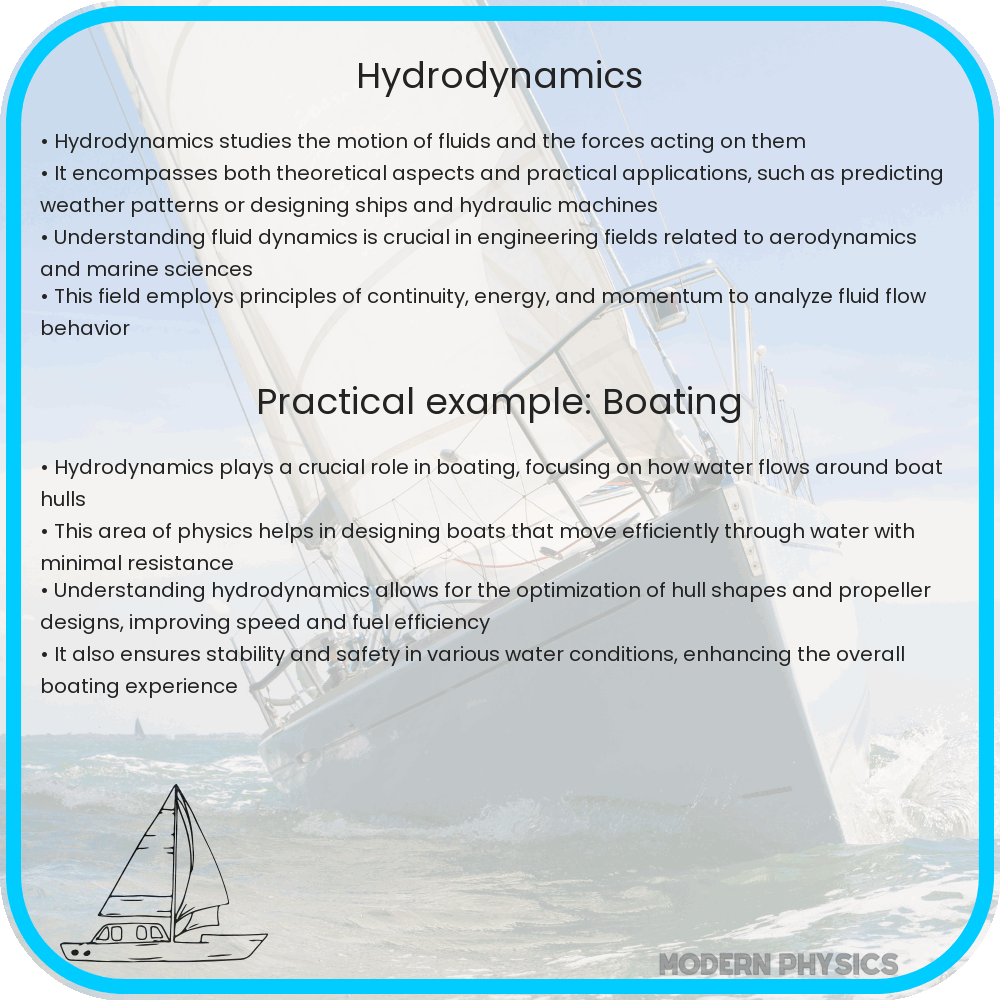Explore the fascinating world of hydrodynamics: learn about fluid motion, forces, and energy dynamics in various fields and future advancements.

Understanding Hydrodynamics: The Science of Fluid Motion
Hydrodynamics, a branch of physics, delves into the study of fluids in motion. This field encompasses the understanding of the behavior of liquids and gases, exploring the forces and energy dynamics involved. It’s a crucial area of study in various scientific and engineering disciplines, including meteorology, oceanography, aerodynamics, and even blood flow in biology.
The Fundamentals of Fluid Motion
Fluid motion is governed by the principles of continuity and Bernoulli’s equation. The continuity equation, represented as A1v1 = A2v2, where A stands for the cross-sectional area and v for velocity, ensures the conservation of mass in a fluid flow. Bernoulli’s principle, on the other hand, expresses the conservation of energy in a flowing fluid. It states that the sum of the pressure energy, potential energy, and kinetic energy in a fluid remains constant along a streamline. This is mathematically represented as P + ½ρv2 + ρgh = constant, where P is pressure, ρ is fluid density, v is velocity, g is gravitational acceleration, and h is the height above a reference point.
Exploring Forces in Fluid Dynamics
In hydrodynamics, the forces affecting fluid motion are primarily pressure and viscous forces. Pressure force is the force exerted by a fluid per unit area, influencing the flow direction and velocity. Viscous force, related to the fluid’s viscosity, opposes the flow, creating internal friction. These forces are crucial in the Navier-Stokes equations, which describe the motion of fluid substances. These equations, albeit complex, are fundamental in predicting weather patterns, designing aircraft, and understanding ocean currents.
Energy Dynamics in Fluids
Energy dynamics in fluid motion involve the transformation and transfer of energy within the fluid system. This includes kinetic energy, associated with fluid motion, potential energy, related to the position of the fluid in a gravitational field, and thermal energy, associated with the fluid’s temperature. Understanding these energy transformations is essential in hydroelectric power generation, heating and cooling systems, and environmental studies.
Hydrodynamics plays a pivotal role in understanding natural phenomena and in the development of technology. By grasping the principles of fluid motion, force, and energy dynamics, we can better comprehend and harness the power of fluids in various applications.
Applications of Hydrodynamics in Various Fields
Hydrodynamics finds its applications in a multitude of fields, showcasing its versatility and importance. In engineering, it aids in the design of ships and submarines, ensuring efficient navigation through water. Environmental science benefits from hydrodynamics in understanding ocean currents, wave formation, and their impact on climate change and marine ecosystems. In medicine, the principles of fluid dynamics are applied in understanding blood flow in the human body, crucial for the development of treatments for cardiovascular diseases.
Computational Hydrodynamics: A Modern Approach
With the advent of powerful computers, computational hydrodynamics has emerged as a significant tool. This involves simulating fluid flows using numerical methods, allowing scientists and engineers to analyze complex fluid dynamics scenarios that are difficult to study experimentally. Computational Fluid Dynamics (CFD) is extensively used in aerodynamic design, weather forecasting, and even in entertainment for realistic simulations of water in video games and movies.
Challenges and Future Directions in Hydrodynamics
Despite its advancements, hydrodynamics faces challenges, particularly in dealing with turbulent flows, which are complex and unpredictable. Understanding turbulence remains one of the most challenging problems in physics. Additionally, the environmental impact of human activities on ocean dynamics calls for more in-depth research and sustainable practices.
The future of hydrodynamics lies in advancing computational methods and integrating them with experimental data for more accurate predictions. There is also a growing interest in exploring the hydrodynamics of non-Newtonian fluids, such as blood and other biological fluids, which exhibit complex flow behaviors.
Conclusion
In conclusion, hydrodynamics, the study of fluids in motion, is a field of immense scientific and practical importance. It plays a critical role in various sectors, from engineering to environmental science and medicine. The principles of fluid motion, forces, and energy dynamics provide a deeper understanding of the natural world and assist in technological advancements. As computational methods continue to evolve, the potential for new discoveries and applications in hydrodynamics is vast. Embracing these challenges and opportunities, the field of hydrodynamics will undoubtedly continue to be a key player in scientific innovation and in addressing some of the pressing issues facing our world today.
